new posts in all blogs
Viewing: Blog Posts Tagged with: Picture Book Monday, Most Recent at Top [Help]
Results 1 - 25 of 172
How to use this Page
You are viewing the most recent posts tagged with the words: Picture Book Monday in the JacketFlap blog reader. What is a tag? Think of a tag as a keyword or category label. Tags can both help you find posts on JacketFlap.com as well as provide an easy way for you to "remember" and classify posts for later recall. Try adding a tag yourself by clicking "Add a tag" below a post's header. Scroll down through the list of Recent Posts in the left column and click on a post title that sounds interesting. You can view all posts from a specific blog by clicking the Blog name in the right column, or you can click a 'More Posts from this Blog' link in any individual post.
I love seasonal picture books, because I love the way they connect us with what is going on outside at this particular moment. They connect us to a rhythm that is bigger than the one that many of humans seem to follow. Today's picture book takes us into a snowy, wintry landscape that is beautiful and stark. On the pages we meet a determined little mouse who is trying to collect firewood so that he can keep his family warm.
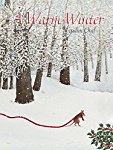 A warm winter
A warm winterFeridun Oral
Picture Book
For ages 4 to 6
Minedition, 2015, 978-988-8341-29-0
One cold winter’s day Little Mouse leaves the comfort of his nest to go out into the snow to find some firewood. Trailing his red scarf, which is very long indeed for such a small animal, Little Mouse finds twigs, pinecones and sticks until he has a huge pile.
Little Mouse ties up the pile with his scarf, rests a little and then he tries to pull his load across the snow. There is no way the pile is going to budge. Little Mouse is just too small to pull so much weight.
Little Mouse asks his friend Rabbit for her help. Even when they “join forces” they cannot move the massive pile of firewood. The animals then ask Fox if they can borrow his sled, which he is quite happy to lend them. The firewood is piled on the sled and they all start pulling, but “the pile simply would not budge.”
There is only one thing left to do; the animals are going to have to wake up Bear to ask for his help. The weather is getting bad and if they don’t get indoors soon everything will soon be buried.
Bear, being a good fellow, is happy to help his friends, even though they woke him up. Together the four animals pull and pull until something very unexpected happens.
This wonderful snowy picture book celebrates friendship, and shows to great effect how wonderful it is when people (or animals) work together to help one another.
This is the time of year when children all over the world hold their wishes close, hoping that Santa, Father Christmas, or St. Nicholas will be able to read the wishes in their hearts and make them a reality. In today's picture book you will meet a little boy who wants more than anything to find a wish tree, which he is convinced is a real thing. Rather than waiting for someone to find such a tree for him, the little boy sets out to find the wish tree himself, and in the process he makes a lot of wishes come true for others.
 The Wish Tree
The Wish TreeKyo Maclear
Illustrated by Chris Turnham
Picture Book
For ages 5 to 7
Chronicle, 2016, 978-1-4521-5065-9
One day Charles decides that he wants to find a wish tree. His older sister and brother say that “There is no such thing” as a wish tree, but Charles, and his friend Boggan, are convinced otherwise and so the next morning the boy and his toboggan set off.
Together the friends climb a hill and sledded down to a “frost meadow” on the other side. Though they do not find a wish tree they do find a squirrel who needs help getting his haul of hazelnuts back to his home in a tree. Boggan and Charles are happy to help out.
Later the friends help a beaver get a load of birch wood back to his lodge, and help a fox get some berries back to her burrow. Again and again Charles and Boggan assist the woodland animals who need help getting food and other materials back to their homes.
The day begins to wind down and poor Charles and Boggan are no closer to finding a wish tree. They have seen so much during the day, except the one thing that they are looking for. Charles is so tired that he decides that he cannot search any longer. In fact he falls asleep on Boggan, which is when something magical happens.
This wonderful wintery picture book will appeal to readers of all ages and backgrounds. Though it is certainly about a little boy’s quest, it is also about friendships that bloom during that quest. With delight we see how gifts are returned to someone who gives of himself so easily and freely.
This morning I woke up to find that it had snowed in the night. The trees and shrubs in our garden, and the grape vines in the vineyard looked as if they had been tucked up under a cozy, fluffy eiderdown. I was grateful that I had managed to get everything ready for the colder months in time, though the baby olive trees in their pots still need to be put under cover so that they don't freeze.
Getting a farm ready for the winter is not an easy task, and in today's picture book you will get to spend some time with a family who spend many busy days putting their farm to bed for the cold season.
 Sleep tight farm: A farm prepares for winter
Sleep tight farm: A farm prepares for winterEugenie Doyle
Illustrated by Becca Stadtlander
Picture Book
For ages 5 to 7
Chronicle Books, 2016, 978-1-4521-2901-3
It is December and the days are getting shorter and darker. The big hay and corn fields are empty, the trees are bare, and all is quiet, but at the farm the people are busy; it is time to put the farm “to bed” for the winter.
Out into the cold morning they go to cover the strawberry plants with hay so that they will be protected from “winter’s frosty bite.” Raspberry plants are also prepared for the winter, their canes cut back so they cannot be cracked by wind and snow.
The last of the fall vegetable crops, kale, carrots, beets and potatoes, are harvested and stored in the barn. The hay was brought in weeks ago and now Dad goes out into the field to plant a cover crop so that the fields are replenished before the next season.
Wood is chopped so that the house will be kept warm through the winter months, and the chicken coop and bee hives are winterized so that the chickens and bees will be warm and safe. This is much to do before the farm and it people can take a well-earned rest.
In this wonderful picture book we see how the members of a family work together to get their farm ready for winter. There is a lot of work to be done, and at the same time there is a lot of gratitude to offer up for all that the farm has given the family in the spring, summer, and fall. The farm has been good to them and they have not forgotten this.
Children often feel very overwhelmed when they see all the problems in their world. Stories about wars, environmental disasters, famines, political conflicts, and social upheavals fill newspapers, news broadcasts, and social media. There is so much wrong out there that they often think that there is nothing that they can do that will have an impact on so much chaos. The truth of the matter is that every little effort that makes the world safer, kinder, and cleaner is a step in the right direction.
Today's picture book shows how some children bring about change for the better in their own little world, and that change, though its impact is not global, is still vital and precious.
 Pond
PondJim La Marche
Picture Book
For ages 5 to 7
Simon and Schuster, 2016, 978-1-4814-4735-5
One cold winter day Matt is out walking when he comes to a place that he and his friends call “the Pit.” It is usually just an open space in the woods that is full of trash, but on this day he sees that a stream of water is bubbling its way out of the ground. Matt looks around and realizes that this neglected place was once a pond and he makes a decision. He is going to bring the pond back.
Matt tells his sister Katie and his best friend Pablo about his discovery, and asks them if they are willing to help him clean the place up. Both agree and the very next weekend the three young people get to work. They pick up all the junk and trash and, with Pablo’s father’s help, take it all to the dump. Then they move rocks to create a dam.
As the days go by and winter softens into spring, the pond starts to fill up. In the summer the children spend time by the water until they are driven off my biting insects and summer storms. Then Matt’s dad decides to help the children work on an old row boat so that it is seaworthy once again. Together they work at patching holes, sanding rough wood, and nailing down boards. The boat is named Dragonfly, and when the children take it out on the water it floats.
As the months go by the pond offers Matt and his friends and family members all kinds of seasonal joys, and it also gives animals a place to call home.
This wonderful book takes us through the seasons with a boy who, thanks to his imagination and hard work, is able to bring back a gift of nature that was lost. A neighborhood pond might seem like a small thing, but the special moments it gives Matt and his friends are precious. As they watch the pond grow and flourish, the children in the story grow to appreciate that sometimes the little things can become big things.
Children who think that they are too small or too young to make a difference in the world will surely be empowered by this tale. They will see that they, like Matt, can bring about change for the better if they really want to.
Learning to be unselfish is one of life's hardest lessons. For most of us remembering to think of others before ourselves is a daily battle, one that we sometimes lose. We know what we are supposed to do. We know that we are supposed to share with others and sometimes give up things we want for their sake, but doing so is just so hard.
In this wonderful picture book we see what happens when a pair of friends find something that they both want. How will they resolve a tricky situation? Will they put friendship first?
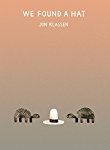 We found a hat
We found a hatJon Klassen
Picture Book
For ages 4 to 7
Candlewick Press, 2016, 978-0-7636-5600-3
One day two turtles are walking in a desert together and they find a wonderful hat, a tall, elegant Stetson. They both try the hat on and compliment each other on how “good” the hat looks. The hat “looks good on both of us,” they say but the problem is that there is only one hat and it would not be fair if one of the turtles had the hat and the other did not. There is only one thing to do. They are going to have to leave the hat where it is and “forget that we found it.”
The two turtles walk to a nearby rock and settle down to watch the sunset. One of the turtles says that he is thinking about the sunset, the other says that he is thinking about nothing but we know that he is thinking about the hat, and looking back to where it lies on the ground. The pull of the hat is strong and the turtle is having a hard time staying true to his friend.
Life is full of difficult choices and often the most hard-to-make ones are those that require that we make a sacrifice. In this wonderful picture book we meet a turtle who really wants something and he is forced to consider if the hat is worth more than the relationship that he shares with his best friend. Thankfully there is someone around who sets an example for him that helps him understand what true friendship is worth.
Many people are convinced that the best stories are ones that are packed with a huge cast of characters, a constantly changing backdrop, a busy back story, and a great deal of drama. To be sure such stories are gratifying and engaging, but smaller, quieter tales can be incredibly rich and rewarding as well. Today's picture book story is just such a tale. The characters are insects, the setting never changes, and the events that unfold are not packed with grandiose spectacles. Instead, we are given a gem of a story that takes us into a small world where powerful and meaningful things happen on a small scale.
 Du Iz Tak?
Du Iz Tak?Carson Ellis
Picture Book
For ages 5 and up
Candlewick Press, 2016, 978-0-7636-6530-2
One day two elegant insects see that a green plant is growing out of the ground and they wonder what it is. A while later three young beetles turn up and the green thing has grown. They too would like to know what the plant is. The beetles climb to the first layer of leaves and they want to go higher to the second set but they cannot reach. They decide to go and ask Icky the caterpillar if they can borrow a ladder. The kindly fellow goes and gets his very long ladder and he props it up against the plant.
With the ladder in place, the three beetles can now climb as high as they like, and when they get up into the higher branches of the plant– which is quite a way up now because the plant is still growing - they decide to build a tree house. Actually they build three tree houses at different levels, and life is wonderful. Then a huge spider builds a web around the houses and the plant, and the beetles can do nothing about the invader who has taken over their home.
In this wonderful picture book, several backyard stories featuring insect characters unfold before our eyes. The insects speak their own language, which is not surprising when you think about it, but luckily we can figure out much of what they are saying and we have no trouble understanding what is going on. What is delightful about this story is that though the main characters are insects, and though the setting in the book is the same one throughout the tale, the story we witness is rich, charming, and satisfying.
Like it or not, we all are, on occasion, prone to being a little self-centered. When the world does not give us what we want we whine and wail about how terrible our life is and how the system is out to get us. In today's book you will meet a penguin who is convinced that every aspect of his life is a disaster, a nightmare. And then someone comes along who helps him gain a little perspective.
This is a deliciously funny book, and it is also one that gives is a gentle, thoughtful reminder that we should take the time to look around so that we see what we are perhaps missing.
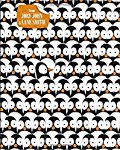 Penguin Problems
Penguin ProblemsJory John
Illustrated by Lane Smith
Picture Book
For ages 5 and up
Random House, 2016, 978-0-553-51337-0
One morning Penguin wakes up “way too early” and immediately he starts to complain. His beak is cold, the other penguins are making too much noise, and it snowed again the night before and he does not really like snow. Or the sun, which is too bright.
Feeling hungry, Penguin heads to the ocean. He finds the water too salty and he does not think he floats enough. In short he sinks “like a dumb rock.” When he dives under water to look for fish he encounters a hungry orca, and a hungry seal, and a hungry shark.
Though he is still hungry himself, Penguin gets out of the water because his flippers are tired from all the hard swimming he has had to do to avoid being eaten. It is hard work swimming when you are a penguin. It’s also hard work walking, or rather waddling, on land. If only Penguin could fly, but he can’t. If only Penguin could figure out which of the many penguins around him is his mother or father but he can’t because all the penguins look alike. If only….
Then a walrus comes over to a now thoroughly upset Penguin and offers him a few sage words of advice.
It is all too easy to get disgruntled about one’s life, to spend one’s days complaining about all the things that are not perfect, and to feel much put upon by one’s circumstances. However, behaving in this manner does not really make anything better. In fact, griping and grumbling more often than not just makes us feel worse.
In this clever picture book we meet a very disgruntled penguin who is so busy being upset with his lot in life that he forgets to notice that there are many wonderful things around him, things that should be giving him joy. If only he would bother to notice them.
For many of us, talking to people we do not know is a very hard thing to do. Even when we really want to make friends, taking that step to connect with someone new seems almost insurmountable, especially if it takes us out of comfort zone and forces us to go somewhere that we are not familiar with.
Today's picture book beautifully captures the journey that a character takes when he has to leave the place he knows, to seek out something that he desperately needs.
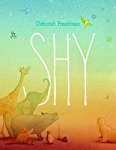 Shy
ShyDeborah Freedman
Picture Book
For ages
Penguin Random House, 2016, 978-0-451-47496-4
Shy is happiest when he is “between the pages of a book,” when he can go to “a land far away” and experience “once upon a time.” Shy particularly loves books about birds, where he happily reads about their beauty and their songs. The sad thing is that Shy has never heard real bird song because the birds in books cannot sing.
Then one day a little yellow bird flies by, a real bird that sings. Shy is delighted, and overwhelmed. He would love to talk to the bird but has no idea how to do so. What if he makes a mess of things, what if he makes a fool of himself, what if…
And then the bird is gone.
Shy so wants to follow the bird, but he has never left his safe little hiding place within the pages of books. He has never ventured out into the world. Though he is afraid, Shy leaves his home for the first time in his life and what he sees as he seeks out the bird amazes him. There are all kinds of animals, and there are birds, lots of birds. Shy hears the song of his bird and follows, and then comes that moment when he needs to speak, to connect with the bird, but Shy cannot get the words out and then…
The bird is gone again and Shy is alone once more.
Many of us find it very hard to venture away from the places that make us feel safe, the places that we are used to. If we are lucky, something comes along that pulls us out of our safe areas, and we enter a world full of marvels and possibilities, the most precious of these being friendships and connections with others. This remarkable picture book explores the journey a very shy character makes when something from the outside world touches him so such a degree that he has to follow; he has to leave the safety of his book for the sake of something wonderful.
So many of the world's problems arise because we think everyone thinks and sees things the way we do. We dare to think that they if they
don't see things our way, then they are in the wrong. We forget that who we are - our life experiences and our background - hugely affect our perceptions.
This amazing picture book shows us how different characters all see the same thing in very different ways. Their viewpoints are startling, visually, and give us cause to pause. As we look at the artwork we are gently reminded to think about how we perceive our world.
 They all saw a cat
They all saw a catBrendan Wenzel
Picture Book
For ages 5 and up
Chronicle Books, 2016, 978-1-4521-5013-0
A cat, wearing a red collar that has a little yellow bell attached to it, goes out into the world with its whiskers ready and its tail in the air. The cat is seen by a child, a dog, a fox, a goldfish, a mouse, a bee, a bird, a flea, a snake, a skunk, a worm, and bat. One would think that they would all see the cat in the same way, but this is not the case.
To the child the cat is a smiling, benign animal that is there to be patted. The dog sees the cat as a lean, mean looking creature. The goldfish, from its watery home in a fish bowl, sees a blurry shape with enormous yellow eyes. For the poor mouse the cat is a monstrous beast with yellow, slit eyes, huge claws, and sharp fangs. The bee, with its compound eyes, sees a pointillist cat, a vague figure made up of lots of colors. The bat, flying in the night sky, also sees a shape made up of dots, but the dots it sees are white in color.
Every animal sees the cat differently depending on its perspective and its place in the food chain. The kinds of eyes and senses they have also determine what the cat looks like to them. How does that cat see itself?
This wonderful picture book takes children on a journey into the imagination. It also presents them with the idea that different characters will see the same thing in widely different ways. We all view the world through eyes that are touched by our biases, interests, and backgrounds, and therefore we have to be sensitive to the fact that other people’s perceptions are not like our own.
The imagination is a powerful thing. Indeed, if people did not have an imagination many books, pieces of music, and art would never be created. Today's picture book celebrates the imagination in a unique and exciting way. Readers of all ages may find themsleves wishing that they too could create a city, through their imagination, that is like the one that they visit in this title.
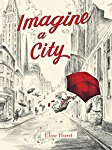 Imagine A City
Imagine A CityElise Hurst
Picture Book
For ages 5 to 7
Random House, 2016, 978-1-101-93457-9
Imagine if you can what it would be like to get on a train, a train that is going to take you to the city so that you have a special outing. It is an ordinary train that stops at an ordinary train platform. You get on board and off you go. It is not long before a waiter comes around and serves you a luscious tea. You sit on the comfortable seats sipping hot tea and eating delicious little cakes and treats. Perhaps you notice that one of the passengers in the car has rather long ears, and paws instead of hands. Or perhaps you don’t.
When you get to the city ordinariness disappears. Here humans and animals live side by side, and there are many strange and wondrous things going on. The pictures in a gallery that you visit refuse to be contained by their frames. Here the buses are fish instead of machines and they swim through the sky above the streets. Here the stories in books, like the pictures at the gallery, will not lie down quietly on the paper. Instead they hop off the pages and sometimes you get quite a shock!
When you stop for a bite in a little restaurant you find that the tables and chairs are little trees. In addition to the now no longer unusual assortment of animals, there are gargoyles partaking of drinks and snacks. It is important to remember that when you can imagine a city there is no accounting for what might happen.
In this visually stunning picture book, the author takes us on a journey full of wonderful impossibles and glorious imaginings. A minimal, lyrical text accompanies the art, and together they capture the sense of a place where adventures lie around every corner and where “The World is your teacher.”
This celebration of the imagination will delight readers of all ages, many of whom will wish that they could jump into the pages and visit the land that lies therein.
When I was a child I struggled to understand mathematics. Numbers became my worst enemy and it did not help that I was often ridiculed by my peers when I made mistakes. I even had a teacher who made fun of my struggles, which was terrible. If only I had had the kind of help the little girl in today's book gets when she is trying to learn how to read. Kind, non-judgmental support goes a long way when it comes to learning how to do something that is difficult.
 Madeline Finn and the library dog
Madeline Finn and the library dogLisa Papp
Picture Book
For ages 5 to 7
Peachtree Publishers, 2016, 978-1-56145-910-0
Madeline Finn does not like to read. At all. Anything with words, including the menu of the ice cream truck, is to be avoided. Reading out loud is the worst because then people can hear how she sometimes struggles to make sense of the words, and on occasion they “giggle” when they hear her mistakes. No matter how hard she tries, Madeline Finn’s teacher never gives her a star sticker. Instead, she gets a heart-shaped “Keep Trying” sticker, which is so frustrating.
Madeline Finn wishes very hard that she will get a star of her own, but day after day her reading efforts just aren’t good enough. On Saturday Madeline Finn and her mother go to the library. Madeline Finn reminds the librarian that she does not like to read, which is when the librarian, Mrs. Dimple, shows her a surprise.
The children’s reading area is full of dogs. Real live dogs, and apparently they are there to be read to. Mrs. Dimple introduces Madeline Finn to Bonnie, a beautiful, big, white dog who is apparently a “great listener,” and in spite of herself Madeline Finn decides that she would like to try reading to the dog. She never imagines that Bonnie is going to be more than a good listener.
This wonderful, heartwarming picture book explores one little girl’s reading journey. It is a journey that is full of struggles, frustration, and heartache, but it turns out that a patient and accepting dog is just want the little girl needs.
With an authentic first person narrative and wonderful illustrations, Lisa Papp tells a story that will resonate with everyone who has struggled to learn how to do something new.
For many young people today a book is digital file on a tablet. Print books just aren't a part of their lives. I read books in both formats but I generally prefer a printed book. There is something about how a book feels, how it looks sitting on a shelf, and even how it smells that I love. I have books in almost every room in my home, and book cover images appear in frames on my walls.
In today's picture book you will meet a character who has no idea what a print book is. He is puzzled by the book that his friend is reading because it cannot be twitched on, it doesn't noises, nor can you play games on it. What is the point of a book he wonders. What indeed!
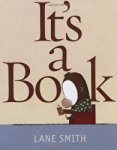 It’s a book
It’s a bookLane Smith
Picture Book
For ages 5 to 7
Roaring Brook, 2010, 978-1-59643-606-0
One day Jackass comes over to where Monkey is reading. Jackass asks Monkey what he has in his hands. Monkey explains that it is a book. Jackass is not sure what a book does so he asks Monkey a lot of questions about the strange object that he is holding.
Jackass wants to know if you can scroll down with a book or blog with it. Does it have a mouse? Can it make characters fight? Does it tweet or use wi-fi- or make noise like Jackass’s laptop? It turns out that a book cannot do any of these things. Monkey shows Jackass that the book he is reading has a story in it about pirates. In Jackass’s opinion there are too many words. As he takes the book and goes to sit down, Jackass learns that the book does not even have a screen name, nor do you need a password to read it. How bizarre!
This wonderful book shows young readers all the things that a book isn’t. Then, in a sneaky and completely silent way, it shows us the wonderful magic that can be found in an object that does not need a power cable, upgrades, or a mouse pad.
With a minimal text, delightful characters, and touches of humor, Lane Smith gives readers a fantastic reading experience.
Not long ago we brought a new kitten into the household. Our two dogs were thrilled to bits to have a new playmate, but the two cats were appalled and disgusted. They behaved as if a fate worse than death had been placed upon them, and were rude and anti-social for days. Thankfully, the kitten's charms have started to wear down the older cats' standoffish behavior. There is only so much you can do when a little furry person snuggles up against you.
In today's picture book you will see what happens when a large and indulged cat called Fuddles gets a new housemate who is.....prepare yourself.....a puppy!
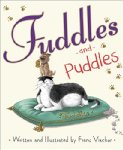 Fuddles and Puddles
Fuddles and PuddlesFrans Vischer
Picture Book
For ages 5 to 7
Simon and Schuster, 2016, 978-1-4814-3839-1
Fuddles is a fat, lazy, and utterly content cat. His people spoil him rotten and that is exactly how things should be. According to Fuddles. Then one day Fuddles wakes up from a nap, he goes into the kitchen, and he sees that there is a puddle on the floor. Worse still there is a little dog that goes with the puddle. A dog that barks and drools, and makes puddles. Fuddles is “disgusted” and he wants nothing to do with the dog.
Unfortunately, Puddles does not seem to understand how much Fuddles dislikes him. The little dog follows Fuddles everywhere, even to the litterbox. Fuddles hardly gets a break from the little pest and one day, when Fuddles catches Puddles eating his food, the cat loses his temper. He has had enough, and so he yowls and is so frightening that the dog runs away and he stays away. Fuddles is “delighted.” He has got rid of the dog pest and now life can settle down and go back to the way it was.
All is well until Fuddles gets himself into a dreadful situation; a situation that means that he needs help and he needs it quickly.
Many of us hate it when change comes into our lives, especially when that change brings inconveniences and perhaps a little chaos with it. What we often don’t realize is that change can actually be a good thing; it can bring unexpected gifts with it that we did not even know about.
With wonderful touches of humor and an appreciation for human (and cat) nature, Frans Vischer brings us a third Fuddles story that will delight readers of all ages.
In 2013 a wordless picture book called Journey came out and it caused quite sensation in the children's book world. In this debut book Aaron Becker tells the story about a little girl who uses magic crayons to go on an adventure. In his next book, Quest, the little girl goes on another journey, one that is packed with even grander adventures, and this time she has a companion with her. Today's picture book is the final title in the trilogy, and just like the first two books in the series, it is wonderfully rich and suitable for anyone who loves beautiful art and storytelling.
 Return
Return
Aaron Becker
Wordless Picture Book
For ages 6 and up
Candlewick Press, 2016, 978-0-7636-7730-5
One day a little girl tries to get her father to spend some time with her, but he is so busy working at his drafting table that she finally gives up, goes downstairs, and uses her magic red crayon to draw a doorway on her bedroom wall. Her father finally realizes that she has gone and so he goes downstairs to investigate, which is when he sees the red door in her bedroom.
The father goes through the door and finds himself in a beautiful forest where lamps hang from the trees. His daughter’s red ball is sitting at the end of a wooden dock. The father picks up the ball, which is when a self-propelled boat sails up the river. The man gets on board and by the light of the moon he travels to a fantastic city. He can see his daughter, who is sitting in a little red rowboat, on the river ahead of him.
When the father finally catches up with his daughter she is with a boy, the king of the land, and a beautiful purple bird. The girl is clearly upset with her father for his neglect earlier and she has no interest in trying to make up with him. Just then the boat the father arrived in opens up and soldiers come out of it. They threaten the king, who responds by using a yellow crayon to draw a sword. The king tries to defend himself, but one of the soldiers uses a special device to suck up the sword, the yellow crayon, and the other crayons the king has. The king and the magical box are then whisked away by the enemy.
The boy quickly draws a large purple gryphon with his crayon and then he and the girl and her father climb on the animal’s back. They fly in pursuit of the kidnappers. They are close to the enemy when one of the soldiers opens the device to suck up the gryphon. The boy is captured by the enemy, but the purple bird, father and daughter fall through the air and land in the water far below. How are they going to save the king and the boy now?
This is the third book in a trilogy that tells the story of a pair of children who use magic crayons to travel to a world that is full of marvels and adventures. Once again the children are called upon to save the day, but this time the girl’s father also has to redeem himself in the eyes of his daughter, who is clearly sorely disappointed in her parent.
Readers of all ages are going to thoroughly enjoy this rich and exciting wordless picture book.
Learning how to deal with problems is a vital skill to have. The funny thing is that many of us have no clue what to do when things go wrong. We wring our hands, have a panic attack, moan and groan, or burst into tears. We try to run away from our problems, or pretend that they are not there. Needless to say, none of these strategies improve our situation in the slightest.
Today's picture book will help readers of all ages to better understand how to deal with a problem. The narrative is beautifully presented without being preachy or pedantic. The story is supportive and it helps readers to think about their problems in a new way.
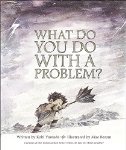 What do you do with a Problem?
What do you do with a Problem?Kobi Yamada
Illustrated by Mae Besom
Picture Book
For ages 5 and up
Compendium Inc, 2016, 978-1-943200-00-9
One day a little boy finds out that he is saddled with a problem, a problem that he does not like, did not ask for, and does not want. He has no idea what he is supposed to do with the problem or what it wants, and not surprisingly he would like it to go away. He tries shooing it, scowling at it, and even ignoring it but nothing works.
The thing about problems is that they can cause a lot of new problems. People worry about them, and get anxious that their problem will do something to them or change their life in some dreadful way. The worry builds on itself and unfortunately this only makes the problem bigger.
No matter what the little boy does his problem can always find him, and the more he tries to avoid it “the more I saw it everywhere.” The problem is taking over his life!
No matter how old you are problems can get the better of you. They worry at you and make you so miserable that you start to feel as if your life is just one big, uncontrollable problem. Thankfully the author and the illustrator of this remarkable book understand exactly what this feels like, and they offer readers support that is simple and yet profound. It turns out that problems contain something special and surprising.
Not long ago I had a day when everything seemed to go wrong. The hose attacked my ankles and I fell over. The dishwasher dumped water all over my feet. A stack of books fell over onto my toes, which hurt a lot. On and on it went until I began to seriously consider climbing into bed and staying there for the rest of the day. At least in bed I would be safe!
Today's picture book is about a charming little badger character who has a bad day, a day full of little calamities.
 The day everything went wrong
The day everything went wrongMoritz Petz
Illustrated by Amelie Jackowski
Translated by David Henry Wilson
Picture Book
For ages 5 to 7
North South, 2015, 978-0-7358-4209-0
One morning Badger wakes up and he decides that today he will only do “things I enjoy doing.” It is going to be his special day. As soon as he gets out of bed he knocks over his bedside lamp, but thankfully it does not break.
In the best of moods Badger sits down to have his breakfast, which is when he knocks over his cup and it falls to the floor and shatters. Badger is very upset because the cup was his favorite one. Badger then decides that he wants to draw a picture, but he can’t find his colored pencils anywhere. He cannot help feeling rather upset that his day, which was going to be “such a treat” is going so wrong. Perhaps he will be better off in his yard where he always has fun.
While Badger is playing outside he trips and knocks over the wheelbarrow, cutting his knee in the process. Dear me! Badger needs to do something to turn his rotten day into one that is not so full of accidents, and so he heads off to find his friends. Maybe if he leaves home his day will improve.
It turns out that Badger is not the only one having a bad day. Raccoon’s clothesline has broken, Stag has lost his ball, Squirrel has a scratch, Rabbit’s fishing line is tangled, Fox’s front door is blocked, and Mouse cannot figure out how to bake a cake. The bad day seems to be touching everyone in the forest.
Everyone has bad days sometimes, days when nothing seems to go right and when one wishes one could go back to bed. In this charming picture book we meet a badger who is having just such a day and who does his best to turn a bad day into a good one. Children who are having (or have had) a bad day of their own will really appreciate why the animals in the story are so upset.
Many children are put off when they see a book that is full of words. They want pictures to look at, not words! After all, how can words possibly take the place of pictures. In today's picture book we meet a young duck who has this reaction when he finds a book that has no artwork in it. As the story unfolds, the duck discovers something rather remarkable about words, something that opens up a whole new world to him.
 This is not a picture Book
This is not a picture BookSergio Ruzzier
Picture Book
For ages 4 to 6
Chronicle, 2016, 978-1-4521-2907-5
One day a duckling finds a book and, full of expectation, he picks it up. When he opens the book he discovers that the book has no pictures in it, only words. What is the point of a book that has no pictures in it! The duckling then gives the book a hefty kick, but he does not stay angry for long. After all, it’s not the book’s fault that it is picture-less. Feeling a little bad about his behavior, the duckling picks the book up and apologizes for his outburst.
Then a little caterpillar comes along and asks the duckling what the book is. The duckling explains that it is a book “with no pictures,” and the insect then asks if the bird can read what the words say. The duckling is not sure if he can, but he starts trying to figure the words out even though it is not easy for him to do so. He finds words that are funny, and words that are sad. There are even words that “carry you away...”
In this marvelous picture book a little duckling discovers that a book that does not have pictures is actually quite a miraculous thing. Words take more work to figure out than pictures, but in the end the work is worth it. Children are going to love the way this narrative ends, and they may even begin to think about what it is going to be like for them when they can read books, word-filled books, for themselves.
On August 6th, 1945 an atomic bomb was dropped on the city of Hiroshima, Japan. Thousands of people died that day, and many thousands died in the months and years that followed from their injuries, radiation sickness, and cancer. One of these people was a little girl called Sadako. Her story is now famous, and it has touched the hearts of people all over the world. Today I have her story in picture book form, and it is presented in a way that makes this true story accessible to children.
 Sadako’s Cranes
Sadako’s CranesJudith Loske
Translated by Kate Westerlund
Picture Book
For ages 5 to 7
Minedition, 2015, 978-988-8341-00-9
One sunny August day in 1945 a little girl called Sadako and her pet cat were playing by the bank of the river. They lay on the grass, eat rice balls, and tried to catch crickets. Then a big black cloud drifted over everything and with the cloud came “fire and heat.” The cloud destroyed everything around them, and when it passed “Nothing was left but gray ash.”
The years went by and people began to think less about that terrible day and the black cloud. Life went on. Then Sadoko became sick and she had to go to hospital. They learned that the black cloud was responsible for her illness. Sadoko’s brother told her about a legend that said “If you fold 1,000 paper cranes, you’ll get to make a wish.”
Sadoko wanted to get well so she started folding paper cranes. Making the cranes made her happy but doing so also tired her out. Sadoko’s cat kept her company, and tried to keep her spirits up by telling her “stories about things I knew she loved.”
This tale is based on the true story of a real little girl. Sadako Sasaki was living in Hiroshima, Japan, when an atomic bomb was dropped on that city on August 6, 1945. As a result of the radiation, Sadako, like so many other people who lived in Hiroshima, developed leukemia. She heard about the legend of the paper cranes and began to make as many of the origami creations as she could.
By telling the story from the point of view of a cat, the author and illustrator of this beautiful, moving tale adds a layer of intimacy to what is already a powerful story. At the back of the book she tells us a little about the real Sadako and her legacy.
Graphic novels have been around for a long time, but English language titles in this genre that are suitable for younger readers are a more recent phenomenon. Thankfully First Second books and other publishers are now creating many wonderful graphic novels for children and young adults. There are books that are suited to readers who are just starting their reading journey, and there are also books for readers who are comfortable with complex and rich stories.
Today's picture book title is a mostly wordless graphic novel that young children will find captivating. In the story there are robots, a strong-willed, tool-wielding little girl, and plenty of action-filled adventure. What more can one ask for.
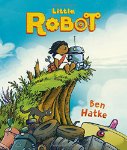 Little Robot
Little RobotBen Hatke
Graphic Novel
For ages 6 to 8
First Second, 2015, 978-1-62672-080-0
One day a little girl sneaks out of her trailer home and she sets off to explore. She sees the other kids going to school, she plays on the swing set in an old man’s yard, and then she goes to a place where lots of old cars are piled up. She finds an old set of tools in a belt, which she takes and slings across her shoulder. Then she sees a box floating in a stream. She pulls the box out of the water, opens it, and finds out that it contains a strange metal canister. When she presses a button on the top of the canister it starts to open up.
The little girl runs away to hide in an old car and watches as the canister opens up some more and then turns into a robot; a not very coordinated robot that tips over on its back when it tries to walk. It lies there with its legs flailing until the little girl takes pity on it and helps it get back on its feet. When the robot tries to walk again it falls flat on its face. Clearly the little machine needs help figuring out how to walk, and the little girl is the one who gives it that help. She also teaches the robot that a cat is not something to be afraid of, and that flowers are alive.
What the robot and the little girl don’t know is that a machine in the factory knows that one of the robots is missing and a large and rather terrifying retrieval robot has been sent to find it.
The next day the little girl and her new friend explore together again. The robot turns out to be very good at skipping stones and the two of them have a wonderful time.
On the third day the little girl and the little robot have a falling out when the little robot seems to prefer hanging out with a broken down car than with her. The girl walks away in a huff. Luckily for the little robot the little girl sees something that makes her think that perhaps something is amiss. She runs back to her mechanical friend just in time to rescue him from being captured by the enormous retrieval robot. They manage to get away from the terrible machine, but their troubles are far from over. The machine is not going to give up without a fight.
This delightful mostly wordless graphic novel tells the story of a special friendship We meet a courageous little girl whose skills with a wrench and screwdriver helps her to do something special. She is the quintessential heroine, and when they get to the end of the story readers will most certainly be left with a warm, fuzzy feeling in their hearts.
Sometimes the people we love the most, our friends and family members, like to do odd things. Sometimes they have strange hobbies or habits that don't really make sense to us, but we go along for the ride because we care about them and want to be with them. In this picture book a dog goes on a very strange journey with his hedgehog friend. He does not quite understand what the hedgehog is doing or why he is doing it, but he goes on the trip all the same.
 Buddy and Earl go exploring
Buddy and Earl go exploringMaureen Fergus
Illustrated by Carey Sookocheff
Picture Book
For ages 5 to 7
Groundwood, 2016, 978-1-55498-714-6
Buddy has had a long day and he is looking forward to snuggling down on his bed for a good night’s sleep. Buddy’s people put Earl the hedgehog in his nice new cage, and then they turn off the light and go to bed. Buddy closes his eyes and is just nodding off when Earl tells him that he is going on a trip.
Buddy is very fond of Earl and does not really like the idea of his friend going off for an indefinite period of time, but Buddy does his best to be brave and he says goodbye to Earl and wishes him “Good luck!” Earl then climbs into his exercise wheel and starts running. He runs and runs and when he stops he sees that the place he has come to “looks eerily similar to the place I just left.” Which is not surprising.
Earl is thrilled when he sees that Buddy is with him in the ‘new’ place. After all, “Exploring is always more fun if you do it with a friend.” Together they set off to explore, with Earl’s very fertile imagination leading the way. Somehow, in the kitchen, they encounter a silvery lake, they eat a feast, Buddy saves a “lovely lady hedgehog trapped in the jaws of a monster,” and in turn Earl saves Buddy from another monster.
In this second Buddy and Earl book, Earl once again let’s his imagination run wild, and though Buddy is a rather literal dog, he goes along for the ride. Children will find it not to laugh out loud when they see how Earl takes the most ordinary of things and turns them into something wonderful. Best of all they will love seeing how the two very different friends stay true to each other no matter what.
There is something incredibly soothing about reading poetry. As it is not prose, the form of writing we are most used to, we tend to take our time with poetry, slowing down our reading so that we can take in the words. Of late the news has been full of awfulness of the worst kind and I have found myself taking refuge from the headlines by reading novels that are written in verse. For a while at least I get a break from violence, anger, frustration, and loss. For children, perhaps today's poetry book will offer a similar little break from the tension that is rippling through our world.
 The Frogs Wore Red Suspenders
The Frogs Wore Red Suspenders Jack Prelutsky
Illustrated by Petra Mathers
Poetry Picture Book
For ages 4 to 6
HarperCollins, 2005, 978-0060737764
One of the best ways to help children engage with poetry is to create poems that make them laugh, or poems that engage the imagination. Jack Prelutsky is a master when it comes to writing poems that contain just the right amount of delightfully silly fun to keep children coming back for more. He also paints pictures with his words to such great effect that children are also drawn to his gentler, more lyrical poems as well.
In this poetry collection, animal and human characters do all kinds of delightful things, the kinds of things that children will enjoy reading about. We begin with a quintet of frogs (wearing red shorts with red suspenders) and a quartet of pigs (in purple vests) who are on a stage. They are singing to an audience of chickens and ducks, all of whom are sitting “upon their nests.” One would think that the noise would scare the birds away, but they are delighted by the croaky and oinky “serenade.” So much so in fact that they “laid enormous spangled eggs / and quacked and clucked with pride.”
In I went to a store we meet a fellow who goes to a store where the storekeepers don’t have any of the things he wants. Instead, they sell him things that he really does not need at all. For example, instead of selling him a pear and a plum they sell him a drum, and instead of some cheese he ends up with a lamp. Clearly this is the kind of store that he should avoid in future!
Then there is Sarah Small who grows all kinds of clothing in her garden. There are galoshes “short and tall,” as well as “Shirts of yellow, hats of red.” If you need pajamas, sweaters, ties, or mittens, shoes or stockings, this is the place to come, for Sarah Small has them all.
This is a book where there is something for everyone, and for every mood. Readers will enjoy dipping into to this poetry collection, and they will come back to it again and again.
When I was young I read a lot of fairy tales. I was given a collection of books written by Ruth Manning Sanders that were full of stories about giants, witches, fairies, ogres and other baddies. I loved those books and I was particularly fond of the tales where the baddies turned out not to be so bad after all. In today's picture book you will encounter the softer side of some baddies, the side that emerges at the end of the day when they are tired and in need of comfort and friendship.
 Good Night, Baddies
Good Night, BaddiesDoborah Underwood
Illustrated by Juli Kangas
Picture Book
For ages 4 to 6
Simon and Schuster, 2016, 978-1-4814-0984-1
The sun is setting and the baddies in the kingdom, worn out by all the bad things that they have done that day, head for the castle that they call home. In ones and twos a giant, an evil queen, a dragon, wolves, witches, a troll, a gnome and others arrive on foot, and through the air. As they enter the castle, they share their news. Did the giant catch Jack the giant killer? Was a treasure that was stolen found?
After a meal is eaten together in fellowship and harmony, the various baddies head off to prepare for bed. The queen takes off her crown and puts on her pajamas. She puts away her poisoned apple, which she will give to Snow White on “another day.” The troll, who has spent so much time waiting for the three goats gruff under his bridge, is having a long bubble bath.
Dressed in their pajamas, Rumpelstiltskin and a wolf settle in front of a crackling fire to read a story, “one that’s sweet, not grim or gory.” One of the other baddies gives the dragon a drink.
When it is time for bed, the witches check under the giant’s bed to make sure that there are no princesses there. After all, they don’t want their large friend to be scared and therefore sleepless.
Most of us are used to booing and hissing at the baddies that we encounter in fairy tales. We route for Little Red Riding Hood, and are pleased when the wicked queen fails to kill Snow White. In this picture book these same baddies that we love to hate are presented to us in a different light. They are tired and weary baddies who, now that their daily baddie work is complete, want the same comforts of home that the rest of us like to enjoy. Children will be tickled to see wolves behaving politely at the dinner table, and a gnome waiting to have a bath, a rubber ducky under his arm. They will find themselves feeling sorry for the giant who is afraid of princesses under his bed, and be comforted by the ways in which the baddies look after one another. It would appear that even baddies have a side that is not-so-bad.
Most of us have something about our bodies that we don't like, that we wish we could change. Our hair is too straight/curly. Our legs are too fat/skinny. Our lips are too plump/thin. In this book you will meet a bird who, thanks to the remarks of others, thinks his legs are too thin. You will also see how, thanks to a fortuitous visit to an art gallery, the bird finds a very unique solution to his problem.
 Bob the artist
Bob the artistMarion Denchars
Picture Book
For ages 5 to 7
Laurence King, 2016, 978-1-78067-767-5
One day Bob the bird decides to go for a walk. It is a beautiful day and he sets off in good humor on his “fine legs.” Unfortunately, Bob seems to be the only animal who thinks his legs are fine. Cat thinks that they are skinny, and Owl thinks that Bob has a “funny stick walk.” Worse still the other birds all make comments about how “puny” Bob’s legs are. Not surprisingly, all this teasing makes Bob feel rather blue. He decides that what he needs to do is to do lots of exercise to make his legs bigger.
Bob goes to the gym and he diligently lifts weights, runs, and does yoga poses. When that does not work, he tries eating a lot to gain weight, but, as so often happens, the weight ends up all around his middle and none of it goes into his thin legs.
Bob finally determines that the only thing to do is to hide his legs under clothes, but the leg warmers, skirts, and coats just make him feel “ridiculous.”
Bob then visits an art gallery. The colors and designs that he sees on the canvasses inspire him to do something unique and creative about his leg problem.
Children are going to love seeing how Bob finds a wonderful, and colorful, solution to a problem that makes him very unhappy. Art therapy comes in many forms and this one is truly unique.
When I was growing up on the island of Cyprus, summer was all about going to the beach. Here in Oregon we have lots of beaches, but only nutters venture into the water because it is so cold. Sunbathing isn't really an option either much of the time because it is too chilly. Still, the beaches are beautiful and we all enjoy walking and tide pooling, and my husband spends hours looking for rocks.
Since summer is now officially here, I thought I would kick things off with a beach book. Enjoy!
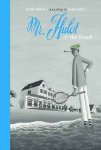 Mr. Hulot at the beach
Mr. Hulot at the beachDavid Merveille
Picture Book
For ages 5 and up
NorthSouth, 2016, 978-0-7358-4254-0
It is a sunny day at the seaside and Mr. Hulot is going to spend some time on the beach. He has a deck chair, an umbrella, a tennis racket and everything else a gentleman might need for such an expedition. He buys a newspaper and then heads for the sands, where he fights with the deck chair for a while trying to get it to cooperate. Which it does. Sort of.
As he reads his newspaper, an inflated beach ball lands on Mr. Hulot. Some people might get upset by a disturbance of this sort, but Mr. Hulot does not mind. He kicks the ball to the little boy it belongs to and, in the process, Mr. Hulot’s shoe comes flying off and lands in the water. He manages to rescue the shoe (using his shrimping net) and then puts it on top of his umbrella to dry.
A passing seagull sees the shoe and decides that it is just what it needs. It swoops down and carries off the shoe, with Mr. Hulot in hot pursuit. Causing a great disruption at the hotel, Mr. Hulot climbs up onto the roof of the building to retrieve the shoe, only to find that the seagull has laid some eggs in it. There is nothing for it. Mr. Hulot returns to the ground shoe-less.
One would think that this escaped would be more than enough of an adventure for one man to have during a sojourn at the seaside, but Mr. Hulot is not your average man and so more misadventures lie in wait for him after he returns to the beach.
Inspired by the work of the French comic actor and filmmaker, Jacques Tati, David Merveille brings Tati’s wonderful Mr. Hulot character to life in this, his second, Mr. Hulot book. The story is wordless and takes readers on a wonderful series of mishaps that are sweetly funny.
Many of us spend a great deal of time and energy looking for a place that we can call home. Often what we are really looking for are the right people, the people who can make anyplace a home for us because they are there. Today's picture book tells the story of a dog who is looking for a place to call her own. It is a sweet and life affirming story that will resonate with readers of all ages.
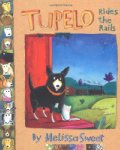 Tupelo Rides the Rails
Tupelo Rides the RailsMelissa Sweet
Picture Book
For ages 5 to 7
Houghton Mifflin Harcourt, 2008, 978-0-618-71714-9
One day Tupelo’s humans dump her, and her sock toy, on the side of the road. Tupelo cannot understand why they would do such a thing, and does not know where she should go next. Not being the kind of dog who gives up, and believing that “Everyone belongs somewhere,” Tupelo picks up her toy, Mr. Bones, and she sets off to find her place.
At first none of the animals she encounters is interested in having her join “their tribe,” but then Tupelo picks up the whiff of something wonderful. She follows the scent and comes across a pack of dogs that are taking part in a bone-burying ritual. They all make a wish to Sirius, the Dog Star, and then bury a bone as an offering to him. The dogs believe that the ritual will bring them “good luck and fortune.”
Under the glimmer of Sirius the dogs all make their wishes and then bury their bones. All of them except Tupelo. She has no bone to bury and she cannot bear to bury Mr. Bones. Instead of wishing, Tupelo decides to follow the dog pack. The dogs are fed by a hobo called Garbage Pail Tex and then the man and all the dogs hop on a train. The hobo tells the dogs about famous dogs from history, dogs like Lassie and Toto. He sings them a bedtime song too, and Tupelo wishes that the ride will “last forever.”
When they arrived in Hoboken, Garbage Pail Tex and some of his hobo friends set about reuniting the lost dogs with their families, and finding homes for the others. One by one the dogs go off to be with people who will love and cherish them. Finally, Tupelo is the only one left and she is alone once more with no one for company except Mr. Bones.
In this lovely story about a dog who is looking for a home, Melissa Sweet combines her charming multimedia artwork with a narrative that readers of all ages will love. Anyone who has felt lost and alone at some point will appreciate how Tupelo feels as she tries to find her place.
View Next 25 Posts
 A warm winter
A warm winter A warm winter
A warm winter The Wish Tree
The Wish Tree Sleep tight farm: A farm prepares for winter
Sleep tight farm: A farm prepares for winter Pond
Pond We found a hat
We found a hat Du Iz Tak?
Du Iz Tak? Penguin Problems
Penguin Problems Shy
Shy They all saw a cat
They all saw a cat Imagine A City
Imagine A City Madeline Finn and the library dog
Madeline Finn and the library dog It’s a book
It’s a book Fuddles and Puddles
Fuddles and Puddles Return
Return What do you do with a Problem?
What do you do with a Problem? The day everything went wrong
The day everything went wrong This is not a picture Book
This is not a picture Book Sadako’s Cranes
Sadako’s Cranes Little Robot
Little Robot Buddy and Earl go exploring
Buddy and Earl go exploring The Frogs Wore Red Suspenders
The Frogs Wore Red Suspenders  Good Night, Baddies
Good Night, Baddies Bob the artist
Bob the artist Mr. Hulot at the beach
Mr. Hulot at the beach Tupelo Rides the Rails
Tupelo Rides the Rails